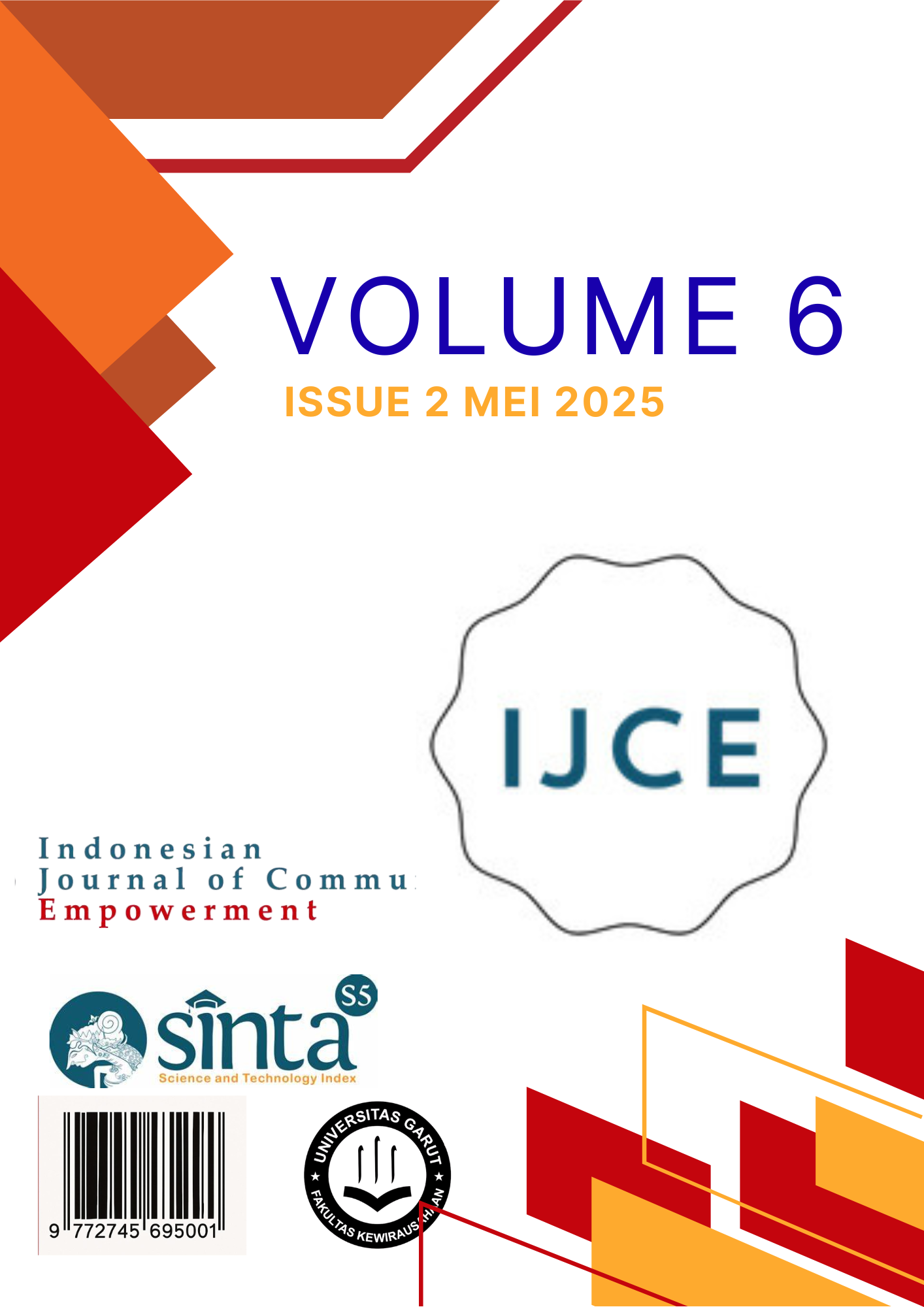English Communication Skills Training for Students through the Communicative Language Teaching Method
Abstract
Given the challenges and needs mentioned above, English language skills training through speaking is a strategic and crucial step for students. This community service activity aims not only to improve their English skills but also to prepare them to face the challenges of an increasingly connected global world. The methods employed include role-playing and group-based projects. The results of this community service activity identified students as possessing English language skills through the CLT method, which plays a role in shifting their learning paradigm from passive and focused on mastering grammatical structures to active, communicative, and meaning-oriented. This training opens new insights into how to learn and use English. English communication skills training through the CLT method successfully equips students with language competencies that are not only theoretical but also practical and contextual. Thus, through this method, students learn to use English as a real-life communication tool that can support academic activities, social life, and prepare them for entering the global workforce.
References
J. S. Warman, V. Mardian, L. Suryani, F. R. Fista, and I. Irwan, “Program Pelatihan Penigkatan Kemampuan Bahasa Inggris Anak-Anak Panti Asuhan Melalui Pemberdayaan Mahasiswa,” Din. J. Pengabdi. Kpd. Masy., vol. 3, no. 2, pp. 280–285, 2020, doi: 10.31849/dinamisia.v3i2.3304.
L. Listyani, “Pelatihan Bahasa Inggris Untuk Mahasiswa Kawasan Timur Indonesia: Sebuah Kebutuhan Di Era Global,” Abdimas Altruis J. Pengabdi. Kpd. Masy., vol. 6, no. 2, pp. 156–162, 2023, doi: 10.24071/aa.v6i2.6964.
Y. Widiana and P. Meilasari, “Peningkatan Kualitas Pemandu Wisata Di Sentani Foresta Madiun Jawa Timur Melalui Pelatihan Bahasa Inggris Berbasis Role-Play,” J. Abdi Masy. Indones., vol. 4, no. 6, pp. 1455–1468, 2024, doi: 10.54082/jamsi.1351.
A. Annisah, W. Waliyudin, M. A. Imaduddin, B. Faturrahman, and Juhriati, “Pemberdayaan Anak Melalui Pelatihan Bahasa Inggris Di Kelurahan Manggemaci Kota Bima,” Joehr, vol. 1, no. 2, pp. 71–78, 2024, doi: 10.34304/joehr.v1i2.256.
L. Lukman, A. Asbah, H. Hijril, R. Ramlah, and N. Nurdin, “Peningkatan Kompetensi Bahasa Inggris Masyarakat Kurang Mampu Di Kabupaten Lombok Barat Propinsi Nusa Tenggara Barat,” JMM (Jurnal Masy. Mandiri), vol. 1, no. 1, p. 79, 2017, doi: 10.31764/jmm.v1i1.17.
G. Abdul et al., “Information Technology Resources and Innovation Performance in Higher Education,” vol. 15, no. 04, pp. 117–125, 2021.
A. A. Alkhaldi, R. F. Alhasan, I. F. Huwari, and H. Abushaaban, “Strategies for Reducing Oral Communication Apprehension in English: A Qualitative Study of Jordanian Undergraduates,” Theory Pract. Lang. Stud., vol. 13, no. 7, pp. 1638–1644, 2023, doi: 10.17507/tpls.1307.05.
S. Sukardi, M. Fadli, D. Puspitawati, D. P. Maharani, and M. Luthfi, “Legal Optic on Digitalization of Cultural Heritage Through E-Tourism and E-Government to Back Up Ecotourism in Greater Malang Indonesia,” J. Ilm. Huk. Leg., vol. 30, no. 2, pp. 182–195, 2022, doi: 10.22219/ljih.v30i2.21420.
A. Kurniawan and Y. M. Hidayati, “Studi Eksplorasi Industri Mebel Mojolaban Dan Integrasinya Dalam Materi Matematika Sekolah Dasar,” J. Basicedu, vol. 6, no. 4, pp. 6695–6702, 2022, doi: 10.31004/basicedu.v6i4.3342.
E. Ariyani, “Pelatihan Bahasa Inggris Aktif Bagi Peserta Kejar Paket B Di Pusat Kegiatan Belajar Masyarakat (PKBM) Rinjani Kota Mataram Nusa Tenggara Barat,” J. Pengabdi. Kpd. Masy. Radisi, vol. 2, no. 1, pp. 11–18, 2022, doi: 10.55266/pkmradisi.v2i1.121.
A. Rofi’i, R. D. Herdiawan, E. Nurhidayat, and A. Fakhrudin, “Keterampilan Berbicara Bahasa Inggris Melalui Pelatihan Yang Efektif Untuk Santri Di Kabupaten Majalengka,” JSK, vol. 1, no. 1, pp. 22–30, 2023, doi: 10.31949/jsk.v1i1.6189.
N. T. Yetik Dwi Vitasari1, “KEWIRAUSAHAAN TERHADAP ENTREPRENEURIAL INTENTION SISWA OTKP SMKN 2 KEDIRI ” Wirausaha adalah sebuah pekerjaan yang terdengar tidak asing lagi bagi masyarakat pada zaman sekarang . Wirausahawan ( entrepreneur ) merupakan seseorang yang bisa mengolah produk,” J. Pendidik. Ekon. Kewirausahaan, Bisnis, dan Manaj., vol. 6, pp. 197–214, 2022, doi: https://doi.org/10.32682/jpekbm.v6i1.2317.
A. Syukur, “Kampung Pulo: Traces of Islamic Culture in Garut Regency, West Java,” Sasdaya Gadjah Mada J. Humanit., vol. 1, no. 1, p. 34, 2016, doi: 10.22146/sasdayajournal.17026.
M. Yahrif, S. Sirajuddin, and N. Utami, “Meningkatkan Kepercayaan Diri Mahasiswa Dalam Berbicara Bahasa Inggris Melalui Kegiatan English Camp,” Reswara J. Pengabdi. Kpd. Masy., vol. 3, no. 1, pp. 77–83, 2022, doi: 10.46576/rjpkm.v3i1.1507.
R. H. Febriyanti and H. Sundari, “Penerapan Penggunaan Platform Materi Video Animasi Dalam Pengajaran Bahasa Inggris Berbasis Daring,” JPPM (Jurnal Pengabdi. Dan Pemberdaya. Masyarakat), vol. 7, no. 2, p. 227, 2023, doi: 10.30595/jppm.v7i2.10215.
H. Sujiono and A. Astuti, “Peran corporate entrepreneurship dalam meningkatkan daya saing perusahaan,” J. Locus Penelit. Dan Pengabdi., vol. 2, no. 12, pp. 1218–1225, 2024.
D. E. Kurniawan and Makin, “Pengaruh Metode Pembelajaran Daring Terhadap Minat Belajar Mahasiswa Di Masa Pandemi COVID-19,” J. Educ. Dev. Inst. Pendidik. Tapanuli Selatan, vol. 9, no. 2, 2021, doi: https://doi.org/10.37081/ed.v9i2.2442.
T. Wu, “Improving the Effectiveness of English Vocabulary Review by Integrating ARCS With Mobile Game‐based Learning,” J. Comput. Assist. Learn., vol. 34, no. 3, pp. 315–323, 2018, doi: 10.1111/jcal.12244.













